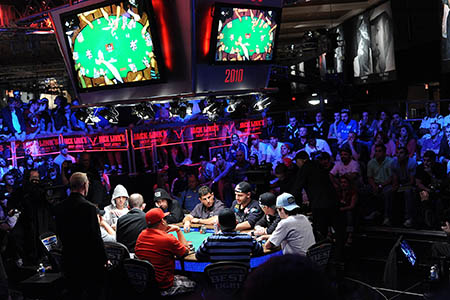
|
| « Articles | History of Playing Cards | Gallery of Playing Cards | Card Games Rules | CONTACT |
The History of Poker's Most Famous Event
On May 30th the 48th edition of the World Series of Poker will take off from its regular haunt of Rio Hotel & Casino in Las Vegas. The WSOP is in fact the most important and largest event when it comes to poker. It is also the longest-running, and the story of how an appointment that no great player would dare to miss became this legendary yearly gathering dates back to almost half a century ago.

In 1970, no more than fifty poker tables could be found at Las Vegas. In spite of this, that year a contest was held at Binion's Horseshoe Casino – although without a dedicated poker room to speak of.
Inspired by a game in Reno, its owner, Benny Binion, decided to take the idea to Las Vegas and, in a small alcove at his venue, got together a few players at what would go down in history as the first edition of the World Series.
The event did not receive much public attention, and the final seven contestants even end up voting for their winner, who turned out to be none other than the legendary Johnny Moss. In the years that followed, Moss was able to set the record straight by actually winning the next edition fair and square, taking home the winner-take-all prize after beating the rest of the players, all of whom had paid a $5,000 entry fee.
In 1973, CBS Sports first televised the tournament, giving the event the national recognition it deserved. Five years later, the WSOP first prize would be divided for the first time among the top five players that made it to the end of the Main Event. In 1979 an amateur by the name of Hal Fowler would win, beating top players in a spectacular fashion. This was a real turning point for the WSOP, as it opened the doors to a wider audience that now felt confident enough to play against the elite.
Over the next years, the World Series of Poker became increasingly popular around the globe and the number of events that took place in each edition grew. Binion purchased the Mint Casino (located next to the Horseshoe) so that the series could finally be hosted in a proper poker room. A temporary tournament area would be added later on.
It wasn’t until 1991 that the World Series of Poker awarded its first one million dollar prize and in 2003, after a few rough years, the tournament leapt from out of from its cult status straight into the mainstream: the Main Event was won by an unknown accountant from Atlanta, Georgia, Christopher Moneymaker, who famously walked away from the November Nine with $2.5 million in prize money having qualified with a $85 buy-in on an online satellite tournament.
Chris Moneymaker gained world-recognition as the guy who had opened WSOP’s proverbial doors to tens of thousands of online gamers feel as if such serious prize money was now within their reach. A little known fact is that in the following year of the tourney, Greg Raymer, another amateur player, won $5 million.
By then, thousands of viewers would look forward to the WSOP every year, with poker players becoming celebrities and the other way around. In 2005, the Series was celebrated for the first time at the Rio, which had the room needed to host what had become a very bustling appointment.
It wasn’t just the crowd-size – the prize pool has continued to grow: in the 2015 edition of WSOP, winner Joe Mckeehen earned $7,683,346 at the Main Event; in 2016, Qui Nguyen walked away with $8,005,310.
Figures for 2017 have yet to be revealed, but what has been confirmed is that we can expect to see close to 500 poker tables at the ballroom of the Rio. It makes it almost impossible to imagine that the furor all began when Sailor Roberts, Carl Cannon, Johnny Moss, "Amarillo Slim" Preston, Doyle Brunson, Puggy Pearson and Crandell Addington came together in a small alcove to play the game they loved almost 48 years ago to the day.